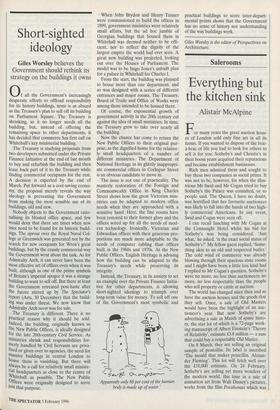Short-sighted ideology
Giles Worsley believes the Government should rethink its strategy on the buildings it owns 0 f all the Government's increasingly desperate efforts to offload responsibility for its history buildings, none is as absurd as the Treasury's plan to sell off its building on Parliament Square. The Treasury is shrinking, so it no longer needs all the building, but, instead of offering the remaining space to other departments, it has decided that commerce has first call on Whitehall's key ministerial building.
The Treasury is studying proposals from two developers submitted under the Private Finance Initiative at the end of last month to buy and refurbish the building and then lease back part of it to the Treasury while finding commercial occupants for the rest. A decision is expected by the end of March. Put forward as a cost-saving econo- my, the proposal merely reveals the way ideology is preventing the Government from making the most sensible use of its buildings, old and new.
Nobody objects to the Government ratio- nalising its bloated office space, and few would deny that there are times when new uses need to be found for its historic build- ings. The uproar over the Royal Naval Col- lege at Greenwich was generated not by the search for new occupants for Wren's great buildings, but by the crassly commercial way the Government went about the task. As for Admiralty Arch, it can never have been the most effective set of offices even when it was built, although as one of the prime symbols of Britain's imperial apogee it was a strange building to want to sell off. But there at least the Government retreated post-haste after the furore stirred up by The Spectator's report (Arts, 30 December) that the build- ing was under threat. We now know that Admiralty Arch never was for sale. The Treasury is different. There is no practical reason why it should be sold. Indeed, the building, originally known as the New Public Offices, is ideally designed for the late 20th-century Civil Service. As ministries shrink and responsibilities for- in. erly handled by Civil Servants are priva- tised or given over to agencies, the need for massive buildings in central London to house them is vanishing. But there will always be a call for relatively small ministe- rial headquarters as close to the centre of Whitehall as possible. The New Public Pffices were originally designed to serve Just that purpose. When John Brydon and Henry Tanner were commissioned to build the offices in 1899, government ministries were relatively small affairs, but the ad hoc jumble of Georgian buildings that housed them in Whitehall was deemed neither to be effi- cient, nor to reflect the dignity of the largest empire the world had ever seen. A great new building was projected, looking out over the Houses of Parliament. The model was to be Inigo Jones's unbuilt plan for a palace in Whitehall for Charles I.
From the start, the building was planned to house more than one department, and so was designed with a series of different entrances and major rooms. The Treasury, Board of Trade and Office of Works were among those intended to be housed there.
Of course, the exponential growth of government activity in the 20th century cut against the idea of small ministries. In time, the Treasury grew to take over nearly all the building.
Now the chance has come to return the New Public Offices to their original pur- pose, as the dignified home for the relative- ly small headquarters of a number of different ministries. The Department of National Heritage in its glitzily inappropri- ate commercial offices in Cockspur Street is an obvious candidate to move in.
The issue is not one of practicality. The masterly restoration of the Foreign and Commonwealth Office in King Charles Street shows how the great Victorian min- istries can be adapted to modern office needs when they are approached with a sensitive hand. Here, the fine rooms have been restored to their former glory and the offices wired up for all the needs of mod- ern technology. Ironically, Victorian and Edwardian offices with their generous pro- portions are much more adaptable to the needs of computer cabling than offices built in the 1960s and 1970s. At the New Public Offices, English Heritage is advising how the building can be adapted to the Treasury's needs while preserving its integrity.
Instead, the Treasury, in its anxiety to set an example over the Private Finance Initia- tive for other departments, is allowing short-sighted ideology to triumph over long-term value for money. To sell off one of the Government's most symbolic and Apparently only 80 per cent of the human body is made up of water ' practical buildings to score inter-depart- mental points shows that the Government has no sense of history nor understanding of the way buildings work.
Giles Worsley is the editor of Perspectives on Architecture.


































































 Previous page
Previous page